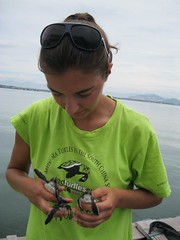
Jessy Cawley, a Civil Engineering major, participated in the CIEE Tanzania program in 2009.
I studied in Dar es Salaam, Tanzania during the Fall and Winter terms of 2009. Dar es Salaam has a population of almost 2.5 million people. As months passed, I explored more and more of the city, visiting another mtaa, or neighborhood, and the anxious bustling somehow transformed into a vivacious tranquility. The first time I rode on the public transportation, a small bus called a “dala-dala”, Beyonce was booming from the stereo and school children navigated on and off the stops wearing their cute blue and white uniforms. I’m continually grateful for my time there. The University of Dar es Salaam is similar in size to our own Oregon State University. I’ve often reflected on my time there. You never know what you’ll learn before you leave for a great adventure to a new place. With every new person/place/circumstance abroad, I learned so much about my own culture and perspective because of the differences and similarities.
I can’t describe the things I’ve learned since going to Tanzania or the things that I’ve observed since returning. If our daily lives were a radio, I somehow have picked up many more stations than I could have tuned into before. I  imagined I would learn a lot about other cultures and share my own, and I did. I really learned a lot about American culture, and I also watched my views on race, poverty, health, and religion evolve in different ways. I refuse to claim I now understand the whole picture, but a lot of stereotypes dissolved. I really encourage all students to study abroad in Tanzania or anywhere you feel lead to go. Also, I really encourage other students to meet the international students on our campus because we, the people of the world, really affect one another in good ways.
imagined I would learn a lot about other cultures and share my own, and I did. I really learned a lot about American culture, and I also watched my views on race, poverty, health, and religion evolve in different ways. I refuse to claim I now understand the whole picture, but a lot of stereotypes dissolved. I really encourage all students to study abroad in Tanzania or anywhere you feel lead to go. Also, I really encourage other students to meet the international students on our campus because we, the people of the world, really affect one another in good ways.










 When I was ten years old my grandpa and I went to Honduras to visit my aunt, who was serving in the Peace Corps. During the two weeks I was there I learned a few key phrases in Spanish, experienced a new culture, made new friends, learned how to make tortillas from scratch, and was awoken early each morning by a rooster. The experience made me look at the world from another perspective and made me appreciate many of the things I took for granted living in the United States, such as clean water, education, and paved roads. That trip was a pivotal moment in my life; I promised myself that I too would one day join the Peace Corps.
When I was ten years old my grandpa and I went to Honduras to visit my aunt, who was serving in the Peace Corps. During the two weeks I was there I learned a few key phrases in Spanish, experienced a new culture, made new friends, learned how to make tortillas from scratch, and was awoken early each morning by a rooster. The experience made me look at the world from another perspective and made me appreciate many of the things I took for granted living in the United States, such as clean water, education, and paved roads. That trip was a pivotal moment in my life; I promised myself that I too would one day join the Peace Corps.









